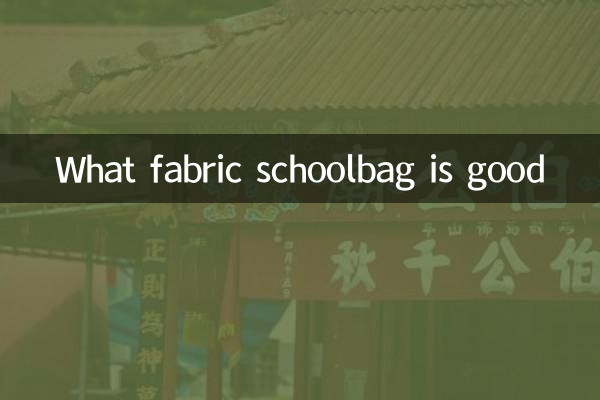What kind of fabric is good for a schoolbag? Analysis and purchasing guide of popular materials on the entire network
With the arrival of the back-to-school season, choosing a durable and comfortable school bag has become a hot topic for parents and students. This article combines the search data of the entire Internet in the past 10 days to analyze the advantages and disadvantages of different fabric schoolbags for you, and provides structured data comparison to help you make a wise choice.
1. Ranking of popular schoolbag materials in 2023

| Ranking | Material type | heat index | Core advantages |
|---|---|---|---|
| 1 | nylon | 9.2/10 | Lightweight, wear-resistant and waterproof |
| 2 | Polyester | 8.7/10 | Cost-effective and easy to clean |
| 3 | canvas | 8.5/10 | Environmentally friendly, breathable, and good load-bearing capacity |
| 4 | Oxford cloth | 7.9/10 | Tear-resistant and durable |
| 5 | leather | 6.8/10 | High-end, beautiful and suitable for business use |
2. Performance comparison of mainstream schoolbag materials
| Material | Wear resistance | Waterproof | weight | price range | Applicable scenarios |
|---|---|---|---|---|---|
| nylon | ★★★★★ | ★★★★☆ | light | 100-500 yuan | Daily commuting, outdoor activities |
| Polyester | ★★★★☆ | ★★★☆☆ | lighter | 50-300 yuan | Daily and short trips for students |
| canvas | ★★★☆☆ | ★★☆☆☆ | medium | 80-400 yuan | Campus use, literary style |
| Oxford cloth | ★★★★★ | ★★★★☆ | heavier | 120-600 yuan | Carrying heavy objects and harsh environment |
| leather | ★★★★☆ | ★★★☆☆ | Heavy | 300-2000 yuan | Business occasions, fashion matching |
3. Purchase suggestions and precautions
1.First choice for student groups: Nylon and polyester materials have become the mainstream choice for student schoolbags due to their lightweight design and durability. Data shows that the sales of these two types of materials will account for 65% in the 2023 school season.
2.Advanced waterproofing solution: If you have higher requirements for waterproofing, you can choose materials with PU coating on the surface. The waterproof level can reach IPX4 or above, which is suitable for use in rainy areas.
3.Environmental health considerations: Recent hot searches show that more and more parents are paying attention to the environmental protection of schoolbag materials. It is recommended to choose products certified by OEKO-TEX® to ensure that no harmful substances remain.
4.Cleaning and maintenance points: The cleaning methods of different materials are quite different. For example, nylon schoolbags can be wiped with a damp cloth, while canvas schoolbags are recommended to be hand washed to avoid deformation, and leather schoolbags require special cleaning agents.
4. The most popular schoolbag material matching scheme in 2023
| style type | Main material | Matching of accessories | Examples of popular brands |
|---|---|---|---|
| Burden-reducing spine protection model | high density nylon | EVA back panel + breathable mesh | JanSport,Tiger Family |
| Fashionable and trendy models | Recycled polyester | Reflective strips + metal accessories | Herschel, Fjallraven |
| Business simple style | First layer cowhide | Genuine leather handle + brass buckle | Samsonite, Tumi |
| Outdoor multifunctional model | 1680D Oxford cloth | YKK zipper + waterproof coating | The North Face, Osprey |
5. Expert advice
Professor Wang, a materials expert at the Beijing Institute of Fashion Technology, pointed out: "When choosing schoolbag fabrics, you should comprehensively consider the use scenario, load-bearing requirements and budget. The new composite materials currently popular on the market, such as nylon and polycarbonate blended fabrics, maintain lightweight characteristics while improving tear resistance, which is a new direction for technological development."
According to consumer survey data, 83% of parents are most concerned about material durability when purchasing school bags, followed by weight (67%) and ergonomic design (59%). It is recommended that when purchasing in a physical store, you can judge the material quality through the following simple tests:
1. Rub the fabric with your hands to see if it wrinkles or deforms easily.
2. Check the suture density, the standard should be 6-8 stitches per centimeter
3. Pull the stressed part to test the firmness of the joint.
4. Test with a small amount of water droplets to observe the waterproof effect of the surface
With the popularity of the concept of sustainable development, recent hot searches show that searches for RPET schoolbags made from recycled plastic bottles have increased by 120% year-on-year. This type of environmentally friendly materials will become a future development trend.

check the details

check the details